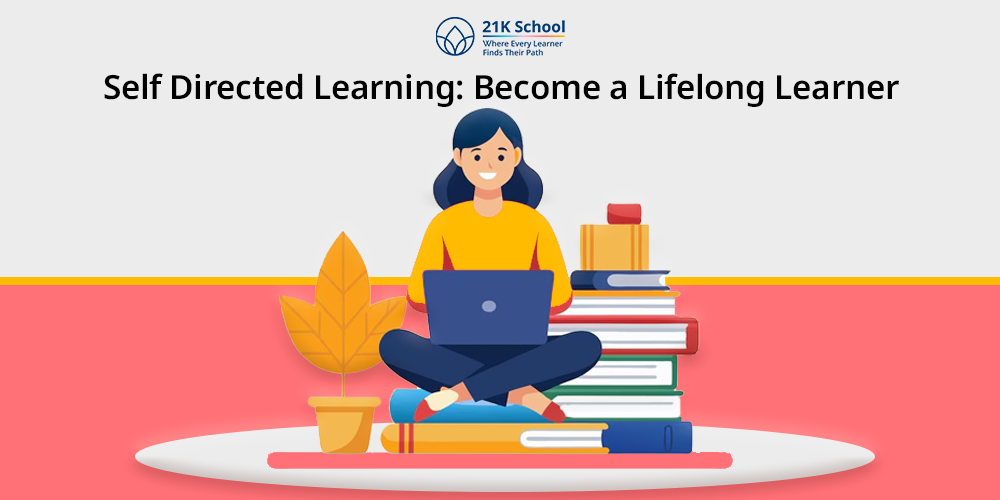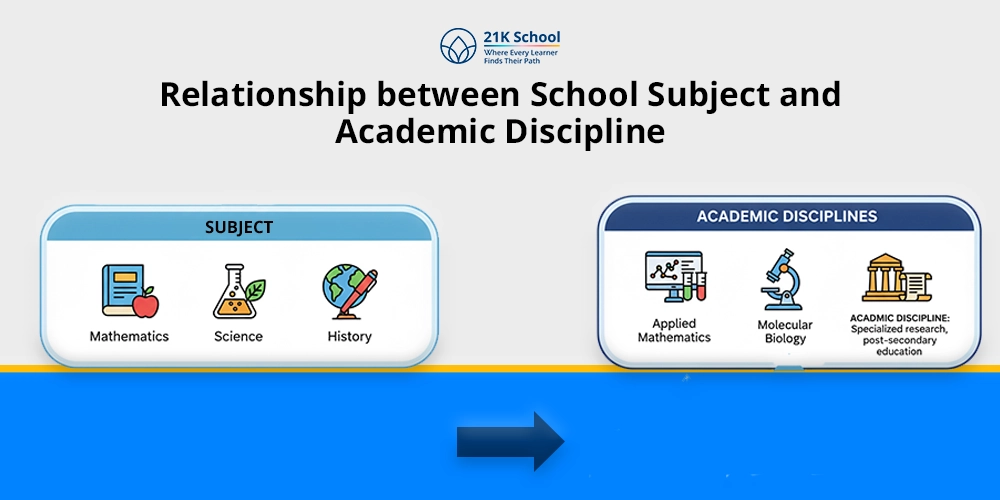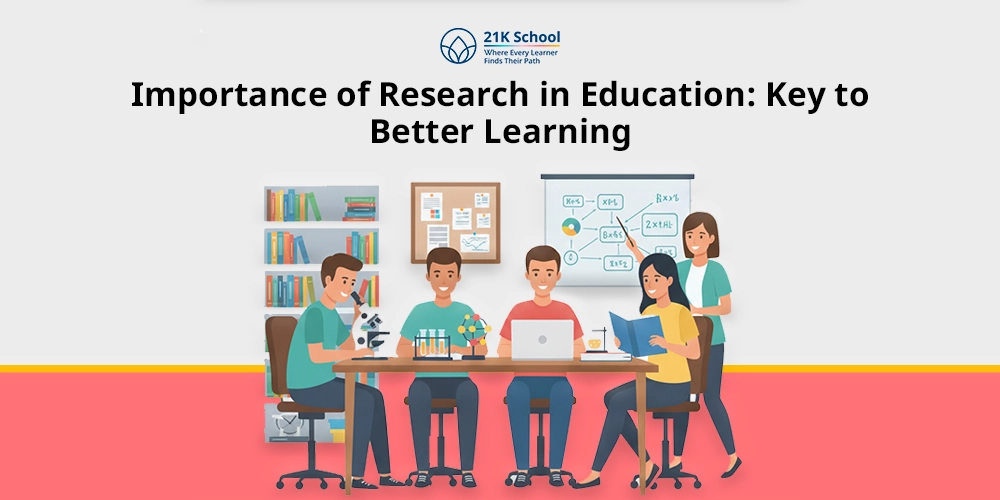
Have you ever thought after finishing classes and completing homework , what’s next? In this changing modern education learning doesn’t stop when school ends.
Learning is just getting started and in this changing world the ability to teach yourself new skills is beneficial. By exploring interests and adapting learning style isn’t just useful, it’s necessary.
That’s where self-directed learning comes into students’ lives.
Self-directed learning is all about taking control of your own growth, learning according to what you want, when you want, and how you want.
If you want to switch careers, want a new hobby or just stay interested in something, lifelong learning can open doors you didn’t even imagine.
Here we will talk about self-directed learning, how to get started, stay motivated and make learning a natural part of your everyday life. Let’s begin!
Table of Contents
- What is Self-Directed Learning?
- Why is Self-Directed Learning Important?
- 4 Stages Of Self-Directed Learning
- Steps to Become a Self-Directed Learner
- Resources and Tools for Self-Directed Learning
- Role of The Teacher in Self-directed Learning
- Real-life Example of A Self-Directed Learning
- Self-Directed Learning v/s Self Regulated Learning
- Benefits of Self-Directed Learning
- Challenges of Self-directed Learning and How to Overcome Them
- The Future of Self-Directed Learning
- Conclusion
What is Self-Directed Learning?
Self-directed learning or SDL is also popular as independent learning, autonomous learning, self-teaching, or autodidacticism.
Self-directed learning means an educational method in which learners take the primary responsibility for their learning process.
This involves identifying learning needs, setting goals, choosing resources and methods and evaluating their progress, often with guidance and support from facilitators.
Self-directed learning is ideal for fostering independence and ownership over an individual’s learning journey.
Why is Self-Directed Learning Important?
Self-directed learning is an essential part of a learner’s educational journey. It fosters deeper understanding, promotes lifelong learning and cultivates essential skills for both personal and professional development .
Here a person can take ownership of their further learning, enhancing motivation and leading to more effective knowledge acquisition.
A deep outlook on why self-directed learning is important:
1. Enhanced Learning
SDL enhances the learning of students and empowers individuals to take ownership of their learning journey.
It fosters greater motivation, deeper understanding and the development of essential lifelong learning skills.
2. Development of Essential Skills
SDL is important to develop essential skills because it fosters autonomy, adaptability, and a lifelong love of learning.
In this fast moving world the technique is ideal where the ability to learn independently and adapt to new situations is highly valued.
3. Cost-Effectiveness
Self-directed learning can be a cost-effective approach to develop skills and knowledge in students. It improves learners’ mindset of continuous learning and adaptability.
By reducing reliance on formal training, utilising existing resources and focusing on relevant skills it can become cost-effective.
4 Stages Of Self-Directed Learning
Self-directed learning or SDL is a method of learning which involves four key stages. First – being ready to learn, second – setting learning goals, third – engaging in the learning process and fourth – evaluating learning.
Each of the stages consider the initial preparation, the development and execution of a learning plan, and in the end, the assessment of progress and reflection on the entire experience.
Here’s a more informative breakdown of each stage of SDL:
1. Preparation
It starts with preparation in which learners set the foundation for successful self-directed learning.
The stage involves self-assessment, goal settings and resource identification, goal setting and resource identification.
Key Activities for Learners includes:
- Work on personal strengths and weaknesses.
- Look forward to what needs to be learned.
- Setting SMART goals means Specific, Measurable, Achievable, Relevant, Time-bound.
2. Research and Implementation
In the next stage learners develop a learning plan, outlining resources, activities, and timelines.
They then engage in active learning experiences like research and implementation or and experimentation.
This stage also involves time management and resource monitoring.
Key Activities for Learners includes:
- Finding useful sources of information.
- Implementation and experimenting with different learning methods for better results.
- Note down everything, schedule for practicing, and applying the information.
3. Evaluation
This stage includes understanding the work progress of learners and customising as per the need.
Key Activities for Learners includes:
- Reflecting on progress by making a sheet.
- Looking for feedback from peers or facilitators.
- Measuring end results and if it lacks then adjust strategy against the original goals.
4. Reflection
The last stage is reflecting on the learning process. Here learners celebrate successes and identify areas for improvement needed.
Reflection guides individuals to grow and adapt their approach for success in future learning.
Key Activities for Learners includes:
- Journaling learning experiences for better outcomes.
- Analyzing personal growth.
- Adjusting future learning strategies based on insights.
Steps to Become a Self-Directed Learner
To become a self-directed learner one needs to focus on actively engaging in the learning process by setting clear goals, finding resources and evaluating your progress.
Here’s an overview of each steps to become a self-directed learner:
1. Assess Your Readiness
Assess your readiness means evaluate current knowledge and skills, Identify the learning style, what inspires you and consider available resources.
These points will ensure that self-directed learning can be developed.
2. Define Your Learning Goals
Before proceeding, defining your learning goals is crucial. Set clear and realistic objectives which help you to increase motivation and willingness to learn.
Define (SMART) specific, measurable, achievable, relevant, and time-bound goals. Also make sure to break down large goals into smaller and manageable steps.
3. Engage in the Learning Process
Engaging in the learning process means choosing appropriate learning resources, actively participating in learning activities and finding a supportive learning environment .
Resources such as find books, podcasts, blogs, and communities. One can also utilize various online platforms like Coursera, edX, and Khan Academy.
4. Evaluate Your Learning
The next important step is to evaluate your learning. To do so you need to reflect on what you have learned and how it applies to your goals.
You can also assess the effectiveness of your learning strategies for better understanding. And if you have achieved the desired goal it’s a win.
5. Cultivate Intrinsic Motivation and Discipline
Intrinsic motivation means the desire to learn for personal fulfillment. It is the driving force behind SDL.
Pairing intrinsic motivation with discipline ensures a sustainable learning engine. This can be done by celebrating small wins, use of Pomodoro timers and habit trackers.
Resources and Tools for Self-Directed Learning
Self-directed learning offers a variety of resources and tools including online learning platforms , educational apps, open educational resources, and community forums.
It helps learners to support their learning goals, enhance knowledge, and develop new skills. Go through a detailed look:
1. Online Learning Platforms
Variety online learning platforms such Coursera, Udemy, and Khan Academy are ideal learning ways for from introductory to advanced levels, across various disciplines.
If you are looking for structured learning paths, assessments and recognized certificates of completion, these platforms offer everything.
2. Educational Apps and Software
Educational apps and software such as Duolingo, Codecadamy, Kahoot! are some of the popular names.
Try these apps and software to enhance your self-directed learning.
3. Courses, Textbooks and Videos
Free online materials from college including lecture notes, assignments, and exams are helpful for learners.
YouTube channels, CrashCourse, Kurzgesagt, open-access textbooks. One can do Podcasts like Lex Fridman, The EdSurge Podcast.
Many of these resources are free or low-cost, making them accessible to learners worldwide.
Role of The Teacher in Self-directed Learning
Teachers act as facilitators, mentors and guides in self-directed learning rather than traditional schooling lecturers.
They understand and support learners and provide the best way to implement self-directed learning in everyday life.
Here’s how they can help students:
1. Establishing Boundaries
In self-directed learning teachers establish boundaries that support student autonomy while ensuring educational standards are met.
They help in defining the scope of learning, creating a positive environment and setting expectations for outcomes and standards.
This gives structure while allowing flexibility to each learner who wants to implement self-directed learning.
2. Teaching Methodology
Teachers can model critical thinking, introduce SDL frameworks and guide students through goal-setting and time management techniques .
They provide tools and strategies to learners for effective SDL.
3. Providing Guidance and Support
Teachers provide guidance, encouragement, emotional support, and expertise for effective SDL. They also provide feedback to ensure better results.
4. Maintaining Educational Standards
While learners define their paths, teachers make sure that academic integrity and learning standards are maintained properly.
5. Promoting Collaboration
Collaborative learning enhances self-directed learning.
Teachers foster group discussions, peer feedback sessions, and community engagement, encouraging social construction of knowledge.
Real-life Example of A Self-Directed Learning
The Story of Ma/lala Yousafzai – A Pakistani Activist
Malala Yousafzai is a Pakistani activist for female education and the youngest Nobel Prize laureate. She is an ideal example who showcases the power of self-directed learning.
Her life at a young age was extremely difficult because she was banned from attending school by extremists. But, she continued her education in secret, reading books at home and teaching herself.
After surviving an assassination attempt by the Taliban for her advocacy, she continued her education in the UK.
Malala Yousafzai was passionate about advocating for girls’ education globally. And today, she is a symbol of courage and a lifelong learner.
Her journey reflects SDL at its finest where inner motivation, strength and self-discipline are fueled.
Self-Directed Learning v/s Self Regulated Learning
Self-directed learning and self-regulated learning both are related methods. However, there is a key difference.
SDL focuses on the student’s autonomy in designing and managing their learning.
On the other hand, SRL focuses on the cognitive and metacognitive processes used to achieve learning goals. It often continues in a structured environment.
Here’s a in depth comparison between self-directed learning v/s self regulated learning:
| S.No. | Particulars | Self-Directed Learning (SDL) | Self Regulated Learning (SRL) |
| 1. | Define | Self-directed learning is a process in which learners take the initiative to find out their learning needs, set goals, find resources, and evaluate results. | Self regulated learning is a process in which learners actively control their cognitive, motivational, and behavioral aspects to achieve learning objectives. |
| 2. | Learner Role | The primary role of the learner is responsible for all phases of learning. | The primary role of the learner is actively managing learning, especially in terms of strategy and effort. |
| 3. | Control of Learning Process | In self-directed learning a high level of autonomy. Here learners choose what, how, when and where to learn. | Self regulated learning mainly focused on managing the process within a given structure or task. |
| 4. | Initiation | It is initiated by the learner, often outside formal settings. | Self regulated learning can occur in both structured formal and unstructured settings. |
| 5. | Goal setting | In self-directed learning learners set their own goals. | In self regulated learning, learners set goals, often in alignment with task requirements or teacher expectations. |
| 6. | Metacognitive Focus | Learners may include planning and reflection, but comparatively less structured. | It has strong emphasis on metacognition: planning, monitoring, and evaluating. |
| 7. | Context | Self-directed learning is often applied in informal, lifelong learning contexts. | Self regulated learning is common in academic and formal learning environments. |
| 8. | Instructional support | Instructional support is minimal or no support. Here the learner navigates independently. | Can be supported by instructors for example, through scaffolding or feedback. |
| 9. | Scope | The scope of SDL is a broader concept encompassing the entire learning process of students. | On the other hand, SRL is a more specific process within a learning context. |
| 10. | Motivation source | Motivation source of self-directed learning Intrinsic is critical and learner-driven. | It includes both intrinsic and extrinsic motivation. |
| 11. | Example | Learner exploring a new language through online resources by personal initiative. | Learner strategies for a test using note-taking, time management, and self-testing. |
Benefits of Self-Directed Learning
Self-directed learning offers numerous advantages, primarily boosting motivation, enhancing flexibility, and improving critical thinking skills .
It also fosters a sense of ownership, leading to increased student engagement and a personalized learning experience.
Here’s a more detailed look at the benefits:
1. Critical Thinking
Self-directed learning significantly enhances critical thinking skills.
By taking ownership of their learning journey, individuals develop the ability to analyze information, problem-solving , and make informed decisions independently.
2. Flexibility
Self-directed learning offers flexibility benefits, allowing individuals to learn at their own pace, in their preferred style, and on their own schedule.
This personalized approach can lead to increased engagement, motivation, and deeper learning retention.
3. Boosts Confidence
Self-directed learning boosts confidence by empowering individuals to take ownership of their learning journey. It fosters a sense of autonomy and accomplishment.
4. Problem Solving
Self-directed learning enhances problem-solving skills by fostering independence, critical thinking, and a proactive approach to challenges.
Learners develop the ability to identify knowledge gaps, research solutions, and implement strategies independently, leading to more effective and innovative problem-solving.
5. Encourage Lifelong Learning
Self-directed learning encourages lifelong learning by encouraging individuals to take ownership of their learning journey, leading to increased motivation, adaptability, and critical thinking skills.
It promotes a growth mindset, resilience, and the ability to navigate a rapidly changing world.
Explore more in detail about the growth mindset in education .
6. Increased Motivation and Engagement
Learners take ownership of their own learning, this helps in increasing motivation and engaging in the process.
This internal motivation can foster more meaningful learning and a stronger sense of achievement.
Challenges of Self-directed Learning and How to Overcome Them
Self-directed learning (SDL) offers numerous advantages, but it also challenges learners. Here’s how it impacts learners:
1. Maintaining Motivation and Self-Regulation
Maintaining motivation and self-regulation are crucial for successful self-directed learning, but several challenges can hinder progress.
These include procrastination, lack of structure, difficulty managing distractions, and insufficient feedback.
Solution, by setting clear goals, creating a structured learning environment, developing effective time management strategies, and seeking support from others one can overcome it.
2. Time Management
Self-directed learning presents unique time management challenges.
One needs to maintain motivation, manage distractions, and balance learning with other commitments.
It can be resolved by setting objectives, creating study time table utilizing time management techniques like the Pomodoro method and seeking support when needed.
3. Self-Doubt and Lack of Confidence
Self-doubt and lack of confidence are significant hurdles in self-directed learning, often leading to procrastination, avoidance, and ultimately, stagnation.
However, by adopting strategies like practicing self-compassion, focusing on strengths, setting realistic goals, and seeking support.
4. Finding Reliable Resources
Self-directed learning presents challenges like finding reliable resources, maintaining motivation, and structuring learning.
Overcoming these hurdles involves establishing clear goals, utilizing reputable platforms, seeking feedback, and fostering a supportive learning environment.
The Future of Self-Directed Learning
The future of self-directed learning looks promising, with increasing recognition of its benefits and the potential for technology to enhance its effectiveness.
Self-directed learning empowers individuals to take ownership of their learning journey, fostering curiosity, creativity, and a lifelong love for learning.
Here’s a closer look at the future of self-directed learning:
1. Personalized Learning
Personalized learning, fueled by self-directed approaches. It is shaping the future of education.
This approach tailors learning experiences to individual student needs, interests, and learning styles, empowering them to take ownership of their educational journey.
2. Interactive and Immersive Experiences
Interactive and immersive experiences nowadays revolutionize self-directed learning.
By offering engaging, hands-on environments that enhance knowledge retention and skill development.
These technologies, including virtual and augmented reality, allow for personalized, active learning that can address diverse learning styles and needs.
3. Data-Driven Insights
The future of self-directed learning is being appropriately shaped by data-driven insights, particularly from learning analytics.
This approach allows learners to understand their strengths and weaknesses, personalize their learning paths, and ultimately become more effective and efficient in their educational journey.
Conclusion
Self-directed learning is not just a method, it is a learning approach that demands constant evolution, the ability to learn independently.
Whether you are a learner, an employee or someone just interested about learning SDL ensures embracing growth of learners.
Self-directed learning also comes with its challenges. It requires discipline, motivation and a willingness to confront your own limits.
As technology continues to advance and resources become more accessible. One needs to control their education. This can start small.
By choosing a topic you are interested in, setting a goal, gathering various tools and beginning the journey. Be a self-directed student and become a lifelong learner.


